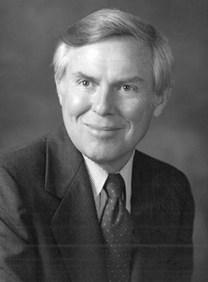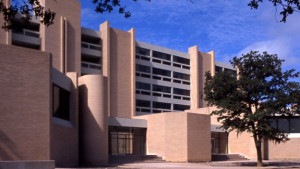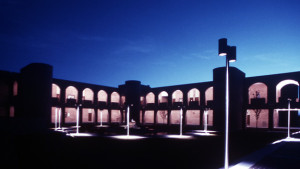
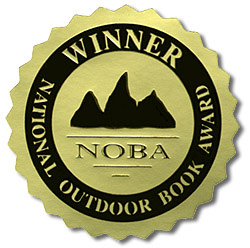 The University of Houston Special Collections congratulates Gail Storey as her memoir, I Promise Not to Suffer, receives the National Outdoor Book Award for Outdoor Literature.
The University of Houston Special Collections congratulates Gail Storey as her memoir, I Promise Not to Suffer, receives the National Outdoor Book Award for Outdoor Literature.
I Promise Not to Suffer: A Fool For Love Hikes the Pacific Crest Trail (Mountaineers Books) recounts the trials and travails faced by Gail and her husband, Dr. Porter Storey, as they trek the 2,663 miles of the Pacific Crest, meeting mountain lions and movie star dogs along the way. This tale of a reluctant hiker and camper, embarking on an odyssey of beauty and anxiety, has been lauded by critics as witty, wrenching, smart, and, not to mention, hilarious.
Describing the sublime beauty and transformative experience in her prose she writes, “Even as my body wore down, my heart opened. Like the snow plant, bursting red through the forest floor. Because of the mountains, the blue space of sky, the softness of green on gray rocks splashed with lichens? Or back in the desert, when colors took the place of thoughts: blue-purple lupines, creamy white yucca, prickly poppy yellow? Now, pearlescent cool air soothed my forehead and my mind settled down.”
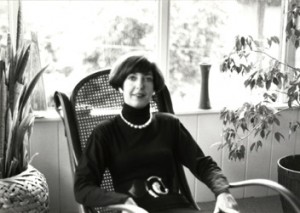
Gail Storey (1992). Photo by Marion Barthelme, from the Gail Donohue Storey Papers.
The author of The Lord’s Motel and God’s Country Club, Storey’s connection to Houston goes back to the early 1980s when she worked for and earned her MA from the prestigious English and Creative Writing program at the University of Houston. Here at Special Collections we are proud to celebrate that connecting thread of Storey’s writing and career as we make available for study the Gail Donohue Storey Papers, a part of our Contemporary Literature collections.
For those interested in learning more about Gail Storey and her writings, be sure to check out her website, the recent interviews with New Dimensions Radio and Colorado Public Library, or visit the Special Collections Reading Room to take a deeper and longer look at the Gail Donohue Storey Papers.
As the Daily Cougar reported yesterday, this spring will mark the 10-year anniversary of the Women’s Resource Center here on the University of Houston campus.
As we mentioned previously, the Women’s Resource Center was founded a decade ago in part based on recommendations from the University Commission on Women. Whether sponsoring the “Take Back the Night” march, hosting “Gender Talk,” or producing the annual “Vagina Monologues,” the staff of the Women’s Resource Center works tirelessly to provide education and resources as part of their mission “to advocate, educate, and provide support services for the advancement of gender equity on campus.”
We would like to issue a hearty congratulations to the WRC as they celebrate a decade of success and growth and look forward to the next ten years. We would also like to remind the community at large that we are very pleased to make available for study the Women’s Resource Center Records here at the University of Houston Special Collections. As part of the Carey C. Shuart Women’s Archive and Research Collection, the UH Women’s Resource Center Records are joined alongside an always expanding number of collections ready for study. We invite you to join us in celebration and study at your earliest convenience and be sure to visit the Women’s Resource Center website for more information regarding ongoing and upcoming events hosted by the WRC.
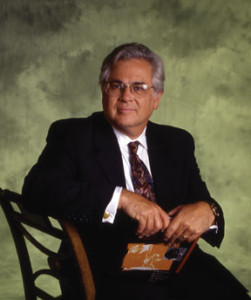
Dr. Kanellos was recently honored by the City of Houston for his work with the “Recovering the U.S. Hispanic Literary Heritage” project
Hispanic Heritage Month came to an end last week, but we would be remiss if we did not mention the recent honor bestowed upon Dr. Nicolas Kanellos, Director of Arte Público Press, by Mayor Annise Parker. As part of the City of Houston’s observance of Hispanic Heritage Month, Kanellos received the Mayor’s Hispanic Heritage Award for Education in recognition for his work with the “Recovering the U.S. Hispanic Literary Heritage” research program.
In the early 1970s Dr. Kanellos founded Revista Chicana-Riqueña, later renamed The Americas Review, and this labor evolved into Arte Público Press which found a home at the University of Houston when he accepted a position here in 1980. Beginning in 1992, Arte Público began the formal work for the “Recovering the U.S. Hispanic Literary Heritage” program. The 2013 catalog of complete titles can be found here.
The University of Houston Special Collections congratulates Dr. Kanellos and his team of scholars whose efforts progress the work of this research program. For those interested in learning more about the nation’s largest and most vibrant Latino publishing house, we remind you how pleased we are to offer the Arte Público Manuscripts Collection and U.S. Hispanic Literary Heritage Records for study as part of our Hispanic Collections and invite you to visit us at your next opportunity.
 Last month Houston, along with six other Texas cities, were awarded the Scenic City Certification by the Scenic City Certification Program of Scenic Texas. Houston, Kennedale, McKinney, Rockwall, Seabrook, and West University Place, Texas will hold the certification through 2018 indicating that citizens in these cities, “through implementation of strong scenic standards… can enjoy an improved quality of life and businesses find it easier to attract customers and employees.” A reception honoring the cities will take place this evening at the Hilton Austin Hotel in conjunction with the annual conference of the Texas Municipal League.
Last month Houston, along with six other Texas cities, were awarded the Scenic City Certification by the Scenic City Certification Program of Scenic Texas. Houston, Kennedale, McKinney, Rockwall, Seabrook, and West University Place, Texas will hold the certification through 2018 indicating that citizens in these cities, “through implementation of strong scenic standards… can enjoy an improved quality of life and businesses find it easier to attract customers and employees.” A reception honoring the cities will take place this evening at the Hilton Austin Hotel in conjunction with the annual conference of the Texas Municipal League.
Specifically, the Scenic City Certification Program commended Houston for the following:
- Strong standards to enhance the visual character of its streetscapes including sign regulation and landscaping
- Emphasis on establishing and protecting parks, trails and open spaces
- Clearly-stated unity of design standards
- Firm prohibition on the conversion of existing non-electronic billboards to digital format
Here at the University of Houston Special Collections, we preserve and make available for study the records of Scenic Houston, a chapter of Scenic Texas, Inc. Anyone who has driven around Houston over the years will find it no surprise that much of Scenic Houston’s work has centered around efforts to reduce the blight of billboard signage around the city (a fact underscored in the commendation above). Records available for study include a history of much of that work but are not limited to strictly local efforts. As the title of the collection would indicate, the Scenic Houston – Scenic Texas records include primary sources related to other local chapters and state & national chapters as well. Also included are records relevant to the Greater Houston Partnership, the Quality of Life Coalition, and the Scenic Conservation Advisory Council.
As Houston and the other cities receive their recognition this evening, it marks another step forward in a long environmental struggle outlined by other collections in our Houston History Archives. We invite you to reacquaint yourself with Houston’s environmental history in our Reading Room at your earliest convenience.
The following comes to us from Dr. Stephen James, who took a moment from his work with the Kenneth E. Bentsen Papers to reflect on the recent passing of Bentsen and his legacy.
The University of Houston lost a distinguished alumnus and friend last week. Kenneth E. Bentsen (Class of 1952) was an architect and a gifted designer. He made beautiful buildings that pleased the people who used them. He built a large and important architectural practice that earned the respect of his profession. Today his many buildings shape the environment of Houston and other Texas cities.
We see his work every day. At the University of Houston he designed Agnes Arnold Hall, Philip G. Hoffman Hall, and the Brown wing of M.D. Anderson Library. At the Texas Medical Center, he designed additions for Baylor College of Medicine, renovated the original buildings of the M.D. Anderson Cancer Center, and did most of the new buildings for Texas Children’s Hospital. Even the parking garages benefited from his talent.
Bentsen worked exclusively for large commercial and institutional clients. He designed two high-rise buildings downtown, the Southwest Tower for Bank of the Southwest and the Sheraton Lincoln Building. Both have been demolished. His best-known work in Houston was The Summit, the city sports arena where the Rockets played until Lakewood Church acquired the building. He created buildings in Galveston for UTMB and in Austin for the State Bar of Texas and the University of Texas School of Business. There were many others—too many to list.
Perhaps his most important work of architecture is one that Houstonians rarely see. Bentsen created the master plan and designed many of the buildings for Pan American University in Edinburg, Texas. Now called the University of Texas-Pan American, it is one of the most important educational and cultural institutions in the Rio Grande Valley. Influenced by the Philadelphia master, Louis Kahn, Bentsen established a distinctive regional style for the campus that the university has maintained to this day. Even without his significant body of work in Houston, this project alone would have been a formidable legacy. Very few architects get the chance to design and build a university campus.
Bentsen was born into a prominent family in the Rio Grande Valley, where his father, Lloyd Bentsen, Sr., was a successful rancher and businessman. His brother, Lloyd Bentsen, Jr., had a successful business career in Houston and was for many years a U.S. Senator from Texas. His son, Kenneth Bentsen, Jr., was a U.S. Congressman from Houston. Rather than follow his father and siblings in a business or ranching career, Bentsen pursued his passion for architecture. He often credited his success to his training at the University of Houston and spoke highly of two of his teachers, Donald Barthelme, Sr. and Howard Barnstone, both celebrated Houston architects.
Earlier this year, the University of Houston Libraries acquired all of Bentsen’s professional papers and drawings. This collection, the Kenneth E. Bentsen Architectural Papers, is now being processed and will be housed in the library’s Special Collections Department.
